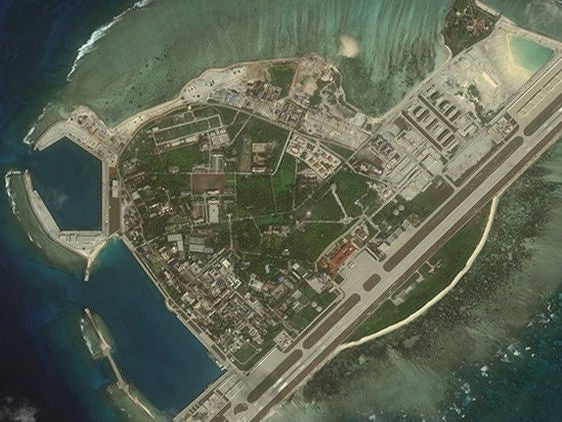China threatens to further fortify its man-made islands in disputed region as tensions with US escalate
If personnel threatened 'we necessarily will take measures to boost defensive capabilities', naval officer warns

Your support helps us to tell the story
From reproductive rights to climate change to Big Tech, The Independent is on the ground when the story is developing. Whether it's investigating the financials of Elon Musk's pro-Trump PAC or producing our latest documentary, 'The A Word', which shines a light on the American women fighting for reproductive rights, we know how important it is to parse out the facts from the messaging.
At such a critical moment in US history, we need reporters on the ground. Your donation allows us to keep sending journalists to speak to both sides of the story.
The Independent is trusted by Americans across the entire political spectrum. And unlike many other quality news outlets, we choose not to lock Americans out of our reporting and analysis with paywalls. We believe quality journalism should be available to everyone, paid for by those who can afford it.
Your support makes all the difference.China may seek to further build up its man-made islands in the South China Sea if it feels the outposts are under threat, one of the country's senior naval officers has said.
The country reserved the right to do as it pleased on the islands it has created in the strategically vital waterway, which it claims virtually in its entirety, according to Senior Captain Zhang Junshe, a naval academy researcher.
”If our on-island personnel and installations come under threat in future, then we necessarily will take measures to boost our defensive capabilities," he said during a briefing with journalists.
China’s claims in the region clash with those of several other countries. Competing claims have been made by Vietnam, the Philippines, Malaysia, Indonesia, Brunei and Taiwan.
The US believes president Xi Jinping has broken a 2015 promise not to expand development in the South China Sea, where Beijing has piled sand and cement on coral reefs to create seven islands, some with airfields and other fortifications.
Both US Navy and Royal Navy vessels have sailed close to these installations to assert international freedom-of-navigation rights in the busy trading route. China says its developments serve primarily civilian purposes.
Capt Zhang accused Washington of endangering safety in the region with its operations, while it warned the UK that it risked endangering any post-Brexit trade deal by engaging in such “provocation”.
At the same briefing, military scientist Lieutenant General He Lei said the People’s Liberation Army would not rule out establishing additional overseas land bases to serve its United Nations peacekeeping missions if necessary – and if host nations approve.
He compared China’s modest overseas military presence to the more than 100 US bases spread across the globe, and claimed China had no intention of using its facilities to project power.
While China cannot yet match the US militarily it has nonetheless displayed “advancements in conventional and asymmetric, especially cyber and AI, technology” in recent years and particularly under Mr Xi, experts have previously told The Independent.
“China cannot realistically catch up in the near to medium term with the US military in either a qualitative or quantitative sense [because] it does not have the economy or skills to do so,” Dr Nicola Leveringhaus, a war studies lecturer at King’s College London, said in an interview last year.
But a bipartisan group of experts warned in a report commissioned by the US congress that America could lose a war against China, particularly if it was forced to “fight on two or more fronts simultaneously”.
They also called for greater military investment.
Additional reporting by AP
Join our commenting forum
Join thought-provoking conversations, follow other Independent readers and see their replies
Comments